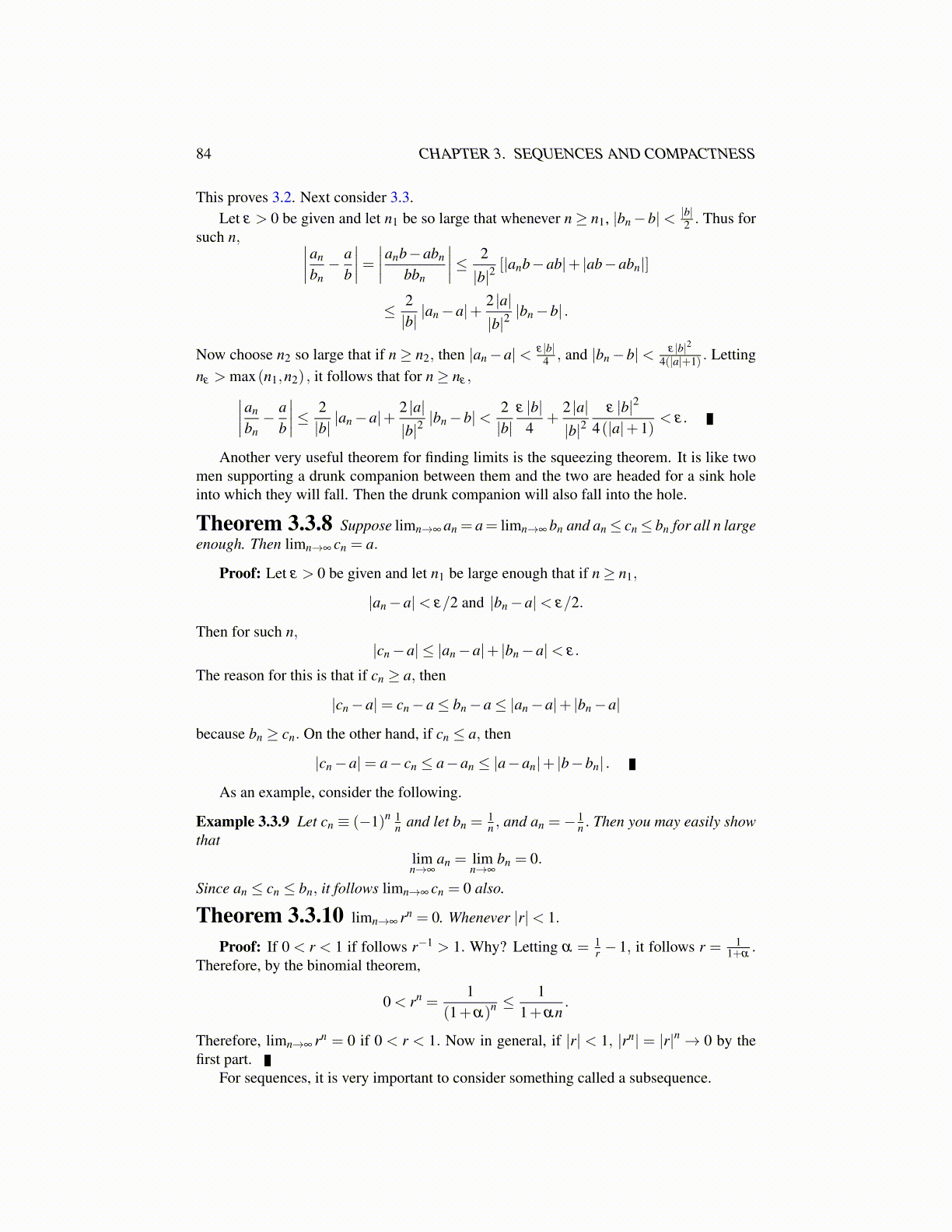
84 CHAPTER 3. SEQUENCES AND COMPACTNESS
This proves 3.2. Next consider 3.3.Let ε > 0 be given and let n1 be so large that whenever n ≥ n1, |bn −b|< |b|
2 . Thus forsuch n, ∣∣∣∣an
bn− a
b
∣∣∣∣= ∣∣∣∣anb−abn
bbn
∣∣∣∣≤ 2
|b|2[|anb−ab|+ |ab−abn|]
≤ 2|b|
|an −a|+ 2 |a||b|2
|bn −b| .
Now choose n2 so large that if n ≥ n2, then |an −a|< ε|b|4 , and |bn −b|< ε|b|2
4(|a|+1) . Lettingnε > max(n1,n2) , it follows that for n ≥ nε ,∣∣∣∣an
bn− a
b
∣∣∣∣≤ 2|b|
|an −a|+ 2 |a||b|2
|bn −b|< 2|b|
ε |b|4
+2 |a||b|2
ε |b|2
4(|a|+1)< ε.
Another very useful theorem for finding limits is the squeezing theorem. It is like twomen supporting a drunk companion between them and the two are headed for a sink holeinto which they will fall. Then the drunk companion will also fall into the hole.
Theorem 3.3.8 Suppose limn→∞ an = a= limn→∞ bn and an ≤ cn ≤ bn for all n largeenough. Then limn→∞ cn = a.
Proof: Let ε > 0 be given and let n1 be large enough that if n ≥ n1,
|an −a|< ε/2 and |bn −a|< ε/2.
Then for such n,|cn −a| ≤ |an −a|+ |bn −a|< ε.
The reason for this is that if cn ≥ a, then
|cn −a|= cn −a ≤ bn −a ≤ |an −a|+ |bn −a|
because bn ≥ cn. On the other hand, if cn ≤ a, then
|cn −a|= a− cn ≤ a−an ≤ |a−an|+ |b−bn| .
As an example, consider the following.
Example 3.3.9 Let cn ≡ (−1)n 1n and let bn =
1n , and an =− 1
n . Then you may easily showthat
limn→∞
an = limn→∞
bn = 0.
Since an ≤ cn ≤ bn, it follows limn→∞ cn = 0 also.
Theorem 3.3.10 limn→∞ rn = 0. Whenever |r|< 1.
Proof: If 0 < r < 1 if follows r−1 > 1. Why? Letting α = 1r − 1, it follows r = 1
1+α.
Therefore, by the binomial theorem,
0 < rn =1
(1+α)n ≤ 11+αn
.
Therefore, limn→∞ rn = 0 if 0 < r < 1. Now in general, if |r| < 1, |rn| = |r|n → 0 by thefirst part.
For sequences, it is very important to consider something called a subsequence.